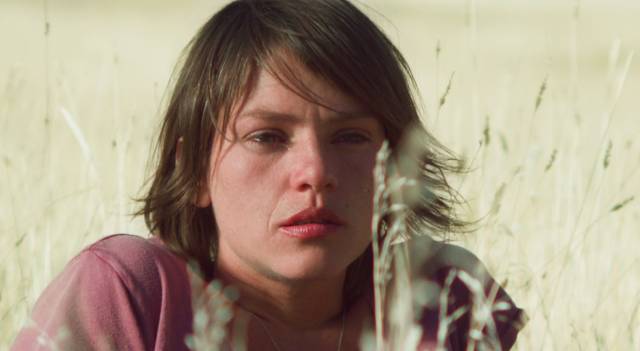
 Come Down Molly defies any “drug film” expectations from the start. The film opens with a long and beautiful, nearly dialogue-free sequence where Molly (Eléonore Hendricks) plays with her year-old son. There is a twinge of melancholy even in what might seem like a Hallmark moment as we see a pretty young mother and a laughing baby. But Molly is sad, she tears up alone in her house and lashes out at her husband. Feeling the burden of early motherhood, Molly takes off for a weekend in the Rockies with her best guy friends from middle school. Soon after her arrival, the group coaxes her into taking magic mushrooms for an experience in “disconnecting from yourself.”
Come Down Molly defies any “drug film” expectations from the start. The film opens with a long and beautiful, nearly dialogue-free sequence where Molly (Eléonore Hendricks) plays with her year-old son. There is a twinge of melancholy even in what might seem like a Hallmark moment as we see a pretty young mother and a laughing baby. But Molly is sad, she tears up alone in her house and lashes out at her husband. Feeling the burden of early motherhood, Molly takes off for a weekend in the Rockies with her best guy friends from middle school. Soon after her arrival, the group coaxes her into taking magic mushrooms for an experience in “disconnecting from yourself.”
Most of the film is shot in the bucolic fields of Colorado and in order to capture the true nature of a mushroom trip, director Gregory Kohn went out with no shooting plan and no real script, encouraging his cast of close friends to improvise. These scenes are built around the scripted framework of Molly’s unhappiness with her newfound mundane routine and loss of the wild child she once was. As Kohn expressed in the publicity notes, this is a narrative not often discussed, especially in the context of a drug trip. We frequently expect women to shed their old lives the instant they have children to lovingly embrace the role of caretaker, but it’s rarely that easy.
Come Down Molly discusses this conflict obliquely but deftly. Written with skill and subtlety, it’s hard to tell the scripted scenes from those improvised. The friends are all in their early thirties and question topics like shifting sexual priorities, plateauing careers, and the importance of being self destructive. With elegant editing that trips with the characters, getting jumpier and edgier as they reach their mushroom peak, the scripted scenes are powerfully integrated through bookends and through what could just as easily be flashbacks or hallucinations.
The brilliance in the “script,” as it were, is in its comedic element. The chemistry between the seven friends is palpable and they are truly hilarious as they wander through the day-long film. In one moment, their friend John holds a flower and gives a near-Mercutian speech on how flowers need bees and bees need flowers and flowers need streams and…fuck bees.
Their humor is a buoy anchored in Hendricks’ intensely moving performance, the stunning Colorado twilight and a needling score. The result gives Come Down Molly an organic and beautiful soul, sort of like that bittersweet feeling of watching a warm sun set as goosebumps begin to prick your arms. In the film, "shrooms" are explained as “getting rid of your sensory filter,” in other words, letting everything in. And that’s just what Come Down Molly does. It is a slow, melancholy, reconnection with nature and a coming to terms with the natural ebb and flow of life.